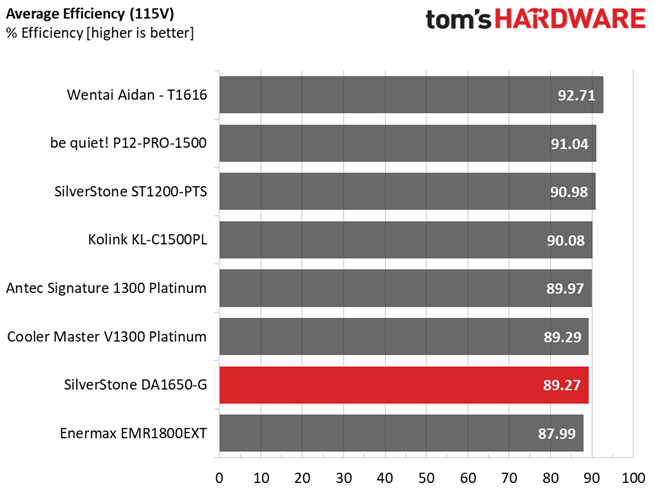Why you can trust Tom's Hardware
Performance Rating
Compared to the much more expensive and digital, Wentai and be quiet! offerings the SilverStone stays behind, but its price tag puts it on a different category where it practically plays alone since you cannot get an EVGA 1600 G2 anymore at a normal price. SilverStone thought wisely to avoid the strong competition in the 1500W and above category and focus more on the performance per dollar score.
Noise Rating
The graph below depicts the cooling fan's average noise over the PSU's operating range, with an ambient temperature between 30 to 32 degrees Celsius (86 to 89.6 degrees Fahrenheit).
At high loads, such a strong PSU will make its presence felt. Nonetheless, the big SilverStone is not among the noisiest high-capacity PSUs.
Efficiency Rating
The following graph shows the PSU's average efficiency throughout its operating range with an ambient temperature close to 30 degrees Celsius.
This is "only" a Gold and Cybenetics ETA-A unit, so it cannot reach higher rating platforms' efficiency levels. That said, it isn't far away from some Platinum competitors.
Power Factor Rating
The following graph shows the PSU's average power factor reading throughout its operating range with an ambient temperature close to 30 degrees Celsius.

The APFC converter's performance is amazing!
Get Tom's Hardware's best news and in-depth reviews, straight to your inbox.
MORE: Best Power Supplies
MORE: How We Test Power Supplies
MORE: All Power Supply Content
Current page: Performance, Noise, Efficiency and Power Factor
Prev Page Transient Response Tests, Timing Tests, Ripple Measurements and EMC Pre-Compliance Testing Next Page Bottom Line
Aris Mpitziopoulos is a contributing editor at Tom's Hardware, covering PSUs.
-
Awev Just wondering, what is the suggested retail price for this? And by offering only a three year warranty how much does that save a person compared to the competition, if you only plan to use it for say 2 1/2 years when the next generation of AMD (AM5 socket) and Intel CPUs are released, along with new GPUs - all requiring more power? How long would you have to own one or the other before it really pays for itself in warranty vs actual expected life?Reply
Please let me know if I missed the price in the article somewhere. -
Endymio And of course 90% of the buyers will be those with systems drawing half or less of that 1650 watts, but who have convinced themselves they "need" the extra headroom.Reply


